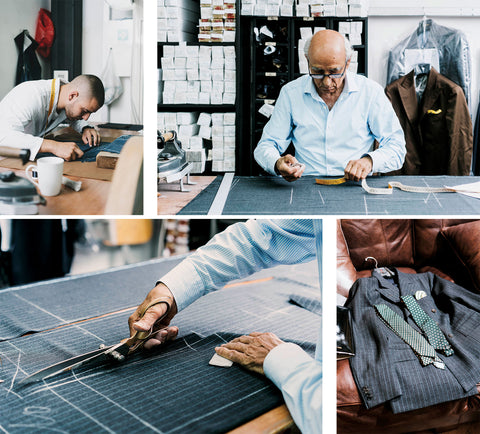
Bespoke vs. Made-to-measure
Share
The difference between bespoke and made-to-measure suits
The quality of a suit highly depends on its material, design and detailed tailoring (how much it fits its wearer). In regards, there are a few expressions to differentiate suits: ready-to-wear, made-to-measure or bespoke. The most popular and easily accessible is the so-called ready-to-wear which means the designer creates a suit that "fits everyone" that can be bought in confection sizes. It became widespread with the appearance of sewing machines, thus series production was made available. Further on the differences between made-to-measure and bespoke suits will be elaborated on.

Pattern-making
Made-to-measure - In this case the ready confection size suit is adjusted to the shape of the customer. It means the length of the trousers and the tightness of the jacket can be modified but fundamental changes cannot be applied. The suit goes through the same process as a ready-to-wear suit thus the same glue technique is used which harms the natural fabrics' breathability. Later, the cleaning process ruins the glue thus the canvas usually begins to swell. Their lifespan is significantly shorter, they can be used for an average of 2 years.
Bespoke - Instead of using general tailoring patterns, the tailor creates a unique pattern in each case based on the wearer's dimensions. This allows every detail to follow the shape of the gentleman perfectly, so a truly unique effect can be achieved. They use natural-based canvases to stiffen the suit, which they shape by hand to fit as closely as possible to the buyer's physique. These canvases breathe together with the fabric, thus ensuring a long life, a bespoke suit can be worn for up to 10 years.
Fittings
Made-to-measure - On the first fitting, the customer tries on a complete suit and they sign the necessary adjustments. Afterwards, the already adjusted suit is given to the customer on the second fitting. During the adjusting process no further fittings are held thus usually no additional adjustments are possible.
Bespoke - At least two fittings take place during the tailoring process, and the process may require multiple fittings if necessary. While this makes the process longer and more complicated, it ultimately allows the tailoring of a higher quality suit. The fittings are performed by the master tailor himself and the changes are drawn on the cut pattern. After the second fitting, the custom cut pattern is stored, which facilitates the process of subsequent orders.
Fabric selection
Made-to-measure - It is possible to choose a unique fabric, however, the manufacturing process is the same in all cases, they do not differentiate according to the unique technological needs of the fabrics.
Bespoke - The customer can choose from the full range of the tailor house, so the end result can be a completely unique suit, which is individually shaped with different technologies according to the fabric quality, and then added to the canvas by hand.

In conclusion, bespoke suits offer more possibilities which means they fall into a higher price range, but a unique, quality suit is the result. For a true 'gentleman' feel, a unique, handmade bespoke suit is definitely the right choice that truly represents the wearer's personality and lifestyle.
//HU
The difference between bespoke and made-to-measure suits


